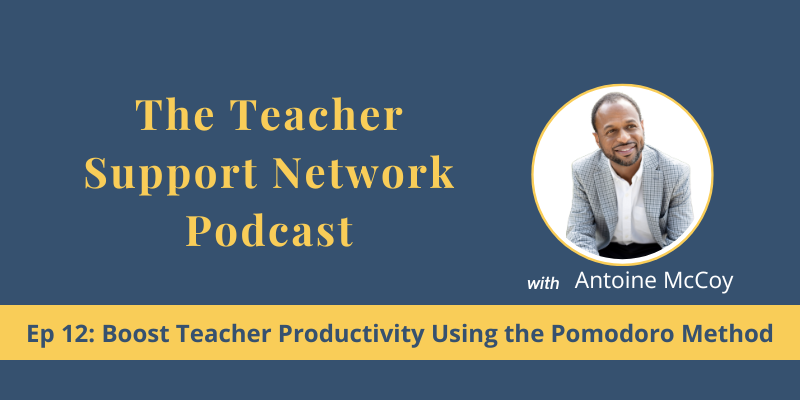
In this episode ~
In this episode of the Teacher Support Network podcast, we explore how the pomodoro method can help educators manage their time more effectively during the school day.
Throughout the episode we discuss the benefits of this technique for teachers and provide practical applications for using the pomodoro method in lesson planning, grading, IEP writing, and other crucial tasks.
Listen in to get the scoop.
Listen in~
00:26 Introduction to the Pomodoro Method
02:04 How Teachers Can Use the Pomodoro Method
03:53 Using Pomodoro for Grading and IEPs
05:14 Managing Emails and Calls with Pomodoro
06:44 Pomodoro Timers and Tools
09:20 Try the Pomodoro Method
Useful Resources:
Download Gen Ed & SpEd Teachers Collaborative Conversations Guide here.
Join my Newsletter for a weekly dose of practical strategies, tips, resources and inspiration to support you on your teaching journey here.
Transcript
Hey Teachers! Welcome to the Teacher Support Network podcast, where we help teachers create collaborative, inclusive classrooms while taking care of your own well being in the process.
Who really likes finding ways to better manage and maximize your time during the school day? I hope all of you have your hands up because I think time is such an important commodity that we don't have a lot of during a school day.
Well today, we're going to be talking about a game changing time management hack called the Pomodoro Method. Have you ever heard of it? So whether you're drowning in lesson planning, grading, or writing IEPs, this technique can really help you get more done in less time without burning out in the process and it's something you can start doing today.
So let's dive right in and let's get right to it. So what is the Pomodoro method? Well, It was developed in the 1980s by Francesco Cirilloand it's super simple. So, you basically work in 25 minute focus blocks followed by a five minute break. So I'll say that again, you work in 25 minute focused blocks, and it's then followed by a five minute break.
After about four of those focus pomodoro sessions you take a longer break that might last between 15-30 minutes. This technique works because our brains can't really focus endlessly without getting tired and getting drained and it needs a break.
It's about breaking work into smaller, shorter sprints so we can stay more focused to prevent crashing and burning out from doing work and we actually can get more done. This technique can work in many different areas of life, but I'm going to talk about how teachers can use this method to be more productive during a teaching day.
So here are some ways that both Gen Ed and SpEd teachers can use the pomodoro method in the classroom. First, let's think about how it can help maximize your time for lesson planning. Lesson planning is something that we all have to do, but sometimes it can take a lot of time to do and can be fun, but draining at times.
So if you're struggling to get through lesson planning, here are some ways that you may use the Pomodoro technique to help you get through that in a more focused and productive way. So that first Pomodoro time session when lesson planning, you might brainstorm and research how you want to teach a certain lesson or even think about the whole unit and you work for 25 minutes and then you take a five minute break.
Then, during another Pomodoro session, you might plan out the details for the lesson itself. You know, the” I do, we do, you do” parts of the lesson. Then take another five minute break. You might do a third pomodoro interval and in this focused time you might think about creating an informal assessment for the lesson, or even a formal assessment for a whole unit.
During this pomodoro session you might be just focusing purely on the assessment piece. Finally, you might have another pomodoro session where you are creating or compiling all the materials, worksheets, and resources you may need for teaching the lesson. So, as I hope you can see, the whole point is you're getting through the lesson planning process, but you're doing it in focus chunks of time and giving yourself a five minute brain break in between each session. That's what's going to really help you stay more productive and, and make the process a lot more enjoyable at the same time.
A second way we can use the pomodoro method is for grading student work in a gen ed class or doing progress reports for students with IEPs if you're a SPED teacher.
So instead of staring at a mountain of papers, how about you set a timer for 25 minutes, grade a chunk of papers or work through progress reports as much as you can, then take a 5 minute break. Then, sit back down and maybe do another session for 25 minutes of grading papers or working through progress reports and then take another 5 minute break.
By doing this, you'll get through the task a lot faster without feeling as drained. The same goes if you're a SpEd teacher working through an IEP. You can use the Pomodoro method to work through the whole IEP or you could break it up into sections and work through specific areas of the IEP.
For instance, you might work on just the present levels for a chunk of 25 minutes and take a five minute break and then get back to it. Or you might just work on the annual goals section for 25 minutes and then take a break. Sometimes it takes a while to get through those pieces and it's a lot of brain work and energy that you're using. Doing it in focused sessions for 25 minutes and then taking a five minute break in between can really help.
Finally, what about those other important tasks teachers have that take up so much of our time, like checking and responding to emails throughout the day and making phone calls to parents and other key people.
What if you blocked off some time and focused on one of those activities for a pomodoro session and then took a break and then moved on to another focused task. So how might it look? For 25 minutes you set a timer and you respond to emails. And then after the 25 minutes, you take a five minute break, and then you can do another session of that, or you could return phone calls for 25 minutes to parents and other key people and then take a break and decompress for five minutes.
Here's the thing. You get to decide how you're going to use the pomodoro technique for all the tasks and responsibilities you have. Just start using it and see if it makes a difference in your productivity throughout the day and getting stuff done. Because a lot of times we go back and forth from task to task and we don't stay focused or give ourselves breaks.
This pomodoro method helps us focus our attention on the things at hand with a built in brain break that can really help us.
What are the best kind of Pomodoro timers and tools to use that are out there? There are tons of them out there. There's physical timers that show time visually. There's different apps you can use on your phone. I use phone apps a lot of times. You can do a Google search and look for an app or go to your app store on your phone. I'm not going to get specific. There are plenty of things out there and then just choose the one that works best for you.
Here's one free way to use the Pomodoro method that I use a lot and I want to share with you because it's something you can use right away. What I do is I go to YouTube and I do a YouTube search. I'll type in Pomodoro 25/5 meaning I want 25 minutes of focused work and then five minutes of break time.
You will get tons of videos that use the pomodoro method and many have great visuals in the background, like nature such as the beach or mountains or lakes. Even if you want to be in a coffee shop or a library. You get to choose what you want and choose a background or environment that really helps you work the best.
They're all out there already and there's so many different versions of them that I think that you can find something that works for you. I often choose one background setting that feels right for me at the moment based on my mood.
Sometimes I want to be in a coffee shop. Sometimes I might want to be on a beach. You know what I mean? But either way, I choose one and I place that visual timer on my second work screen. I have a laptop and I have a bigger screen. So I will put it on one screen while I do my actual focus work on the other screen. That way I can see the time and it'll trigger me when it's time to take a break as well. So that’s a hack that you can try right now and see if something comes up for you that you like. So give it a try, see what comes up, and just have fun with it.
We got to get stuff done. So we might as well do the best we can to maximize our time and stay focused in the process.
So to all the teachers and educators that are listening right now, try the pomodoro method for one week. Set a timer, work in focused blocks, and see how much you can accomplish.
And don't forget to take those five minute breaks. Get up, stretch, get some movement in. Those five minute breaks are built in there for a reason. That's what really makes this method and technique so effective.
Share your experiences with me using the pomodoro method in the comment section on the show notes page for this episode and let me know how it works for you.
Thanks for listening to this episode. If you found this episode helpful, please be sure to subscribe, leave a review, and share with a fellow educator and teacher.
Also be sure to subscribe to my newsletter under the resource section on the show notes page as well. That way I can keep you updated on what's going on in the teacher support network community because this is a growing community and I want to keep you updated on some of the things that are going to be coming up soon.
That's it for now. Until next time, I hope you get more done in your available time, stay focused, and use the pomodoro method and see what it does for you, okay? Have a great week. Bye for now.
Rate, Review, & Subscribe on Apple Podcasts
Enjoy this episode?
Please consider rating and reviewing the podcast! Your support helps me support more teachers - just like you - create inclusive classrooms, foster effective teacher collaboration, and find balance with the demands of teaching in and outside of the classroom
It's easy! Click here, scroll to the bottom, tap to rate with five stars, and select "Write a Review." I'd love to know what was the most helpful or encouraging about the episode!
While you're there, you can subscribe to the podcast if you haven't already. If you're not subscribed, you may very well miss out on future episodes. 🙂 Subscribe now!


